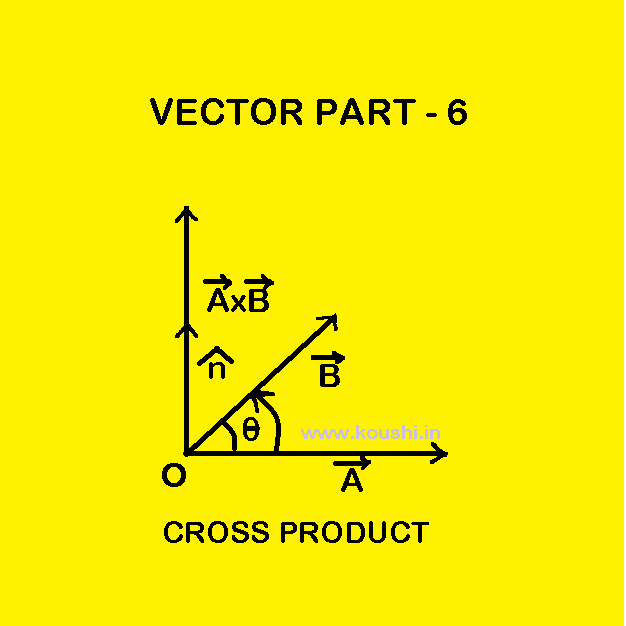Vector product or cross product: The vector product of two vectors ![]() and
and ![]() is defined as the product of the magnitudes of
is defined as the product of the magnitudes of ![]() and
and ![]() and the sine of the angle between them.
and the sine of the angle between them.
If ![]() and
and ![]() creates angle θ then
creates angle θ then ![]()
![]()
![]() = AB
= AB![]() . Where
. Where ![]() is the unit vector perpendicular to the plane of
is the unit vector perpendicular to the plane of ![]() and
and ![]() .
.
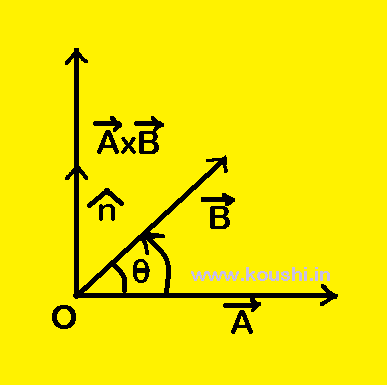
Properties of cross product:
![]()
![]()
![]() = BA
= BA![]() (-
(-![]() ) and |
) and |![]()
![]()
![]() |= BA
|= BA![]() = AB
= AB![]() = |
= |![]()
![]()
![]() |
|
(ii) If the angle between ![]() and
and ![]() is
is ![]() then
then ![]()
![]()
![]() = ABsin
= ABsin![]() = 0
= 0
(iii) ![]()
![]()
![]() = A.Asin
= A.Asin![]() = 0
= 0
(iv) If the angle between ![]() and
and ![]() is
is ![]() then
then ![]()
![]()
![]() = ABsin
= ABsin![]() = AB.
= AB.
(v) ![]()
![]()
![]() =
= ![]()
![]()
![]() =
= ![]()
![]()
![]() = 1.1sin
= 1.1sin![]() = 0
= 0
(vi) ![]()
![]()
![]() =
= ![]() ,
, ![]()
![]()
![]() =
= ![]() ,
, ![]()
![]()
![]() =
= ![]() .
.
Concepts on dot product
1. Area:
Area of a triangle: ![]() and
and ![]() are represented by two sides AB and AC of
are represented by two sides AB and AC of ![]() ABC and CD is perpendicular to AB. Angle between
ABC and CD is perpendicular to AB. Angle between ![]() and
and ![]() is
is ![]() .
.
The area of ![]() ABC =
ABC = ![]() CD.AB =
CD.AB = ![]() ACsin
ACsin![]() AB =
AB = ![]() Qsin
Qsin![]() P =
P = ![]() PQsin
PQsin![]() =
= ![]() |
|![]()
![]()
![]() |.
|.
The direction of area vector is perpendicular outward to the plane of the triangle.
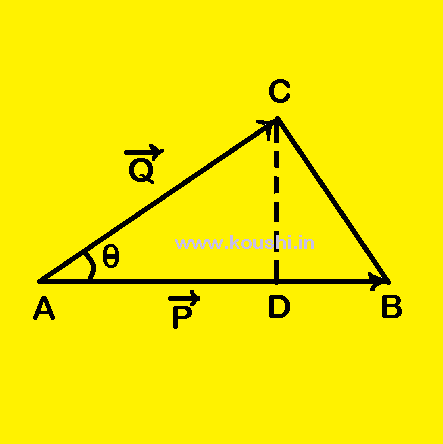
Area of a parallelogram: ABCD is a parallelogram whose sides AB and AD are represented by ![]() and
and ![]() .
.
Area of a parallelogram = 2 ![]() Area of a triangle = 2
Area of a triangle = 2 ![]()
![]() |
|![]()
![]()
![]() | = |
| = |![]()
![]()
![]() |.
|.
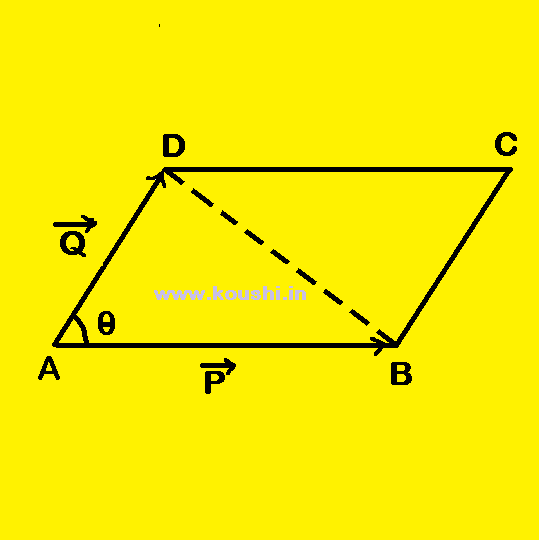
Example: ABC is a triangle and the coordinates of vertices A, B and C are respectively (1, 2, 3), (2, -1, 1) and (3, 1, -2). Find the area of ![]() ABC.
ABC.
![]() =
= ![]() = (3 -2)î + (1+1)ĵ + (-2-1)k̂ = î + 2ĵ -3k̂and
= (3 -2)î + (1+1)ĵ + (-2-1)k̂ = î + 2ĵ -3k̂and ![]() =
= ![]() = (1-2)î + (2+1)ĵ + (3-1)k̂ = – î + 3ĵ +2k̂.
= (1-2)î + (2+1)ĵ + (3-1)k̂ = – î + 3ĵ +2k̂.
The area of ![]() ABC =
ABC = ![]() |
|![]()
![]()
![]() |
|
![]()
![]()
![]() =
=  = (4+9)î + (+3-2)ĵ + (3+2)k̂ = 13î + ĵ + 5k̂.
= (4+9)î + (+3-2)ĵ + (3+2)k̂ = 13î + ĵ + 5k̂.
![]()
![]() |
|![]()
![]()
![]() | =
| = ![]()
![]() =
= ![]()
![]() .
.
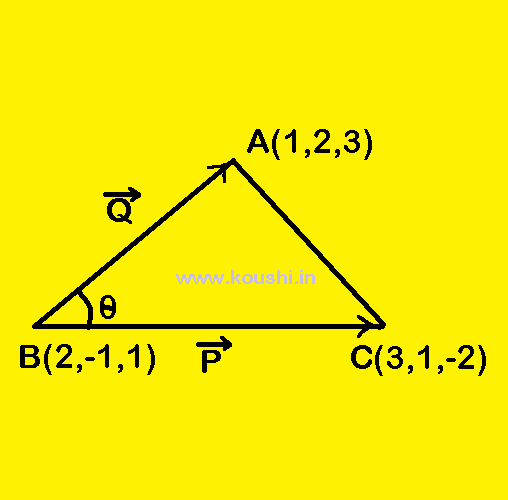
2. Torque: Torque or moment of force about point Q = Force at point P ![]() Perpendicular distance QO = F
Perpendicular distance QO = F ![]() QPsin
QPsin![]() = FRsin
= FRsin![]() = RFsin
= RFsin![]()
![]()
![]() =
= ![]()
![]()
![]() . The direction of torque is perpendicular outward to the plane of
. The direction of torque is perpendicular outward to the plane of ![]() and
and ![]() .
.
Example: Force ![]() = 2î + 3ĵ – k̂ acts at point P (1, 2, 3). Find torque about point Q (2, 1, 1).
= 2î + 3ĵ – k̂ acts at point P (1, 2, 3). Find torque about point Q (2, 1, 1).
![]() =
= ![]() = (1 -2)î + (2-1)ĵ + (3-1)k̂ = -î + ĵ + 2k̂
= (1 -2)î + (2-1)ĵ + (3-1)k̂ = -î + ĵ + 2k̂
![]()
![]() =
= ![]()
![]()
![]() =
=  = (-1-6)î + (4-1)ĵ + (-3-2)k̂ = -7î + 3ĵ – 5k̂.
= (-1-6)î + (4-1)ĵ + (-3-2)k̂ = -7î + 3ĵ – 5k̂.
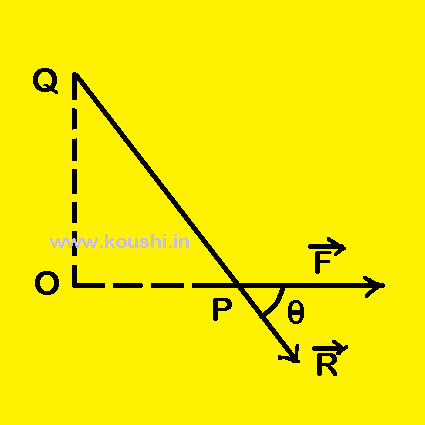
3. Perpendicular unit vector: What is the perpendicular unit vector of ![]() = î +2ĵ – k̂ and
= î +2ĵ – k̂ and ![]() = 2î + ĵ + 2k̂?
= 2î + ĵ + 2k̂?
The perpendicular vector of ![]() and
and ![]() is
is ![]() = |
= |![]()
![]()
![]() |=
|=  = (4+1)î + (-2-2)ĵ + (1-4)k̂ = 5î -4ĵ -3k̂.
= (4+1)î + (-2-2)ĵ + (1-4)k̂ = 5î -4ĵ -3k̂.
Unit vector of ![]() is
is ![]() =
= ![]() =
= ![]() =
= ![]() .
.

4. Volume of a parallelopiped: The three sides of a parallelepiped are represented by ![]() ,
, ![]() and
and ![]() . Area of base of parallelepiped (parallelogram) is
. Area of base of parallelepiped (parallelogram) is ![]()
![]()
![]() = |
= |![]()
![]()
![]() |
|![]() where
where ![]() is the unit vector perpendicular to base of parallelepiped.
is the unit vector perpendicular to base of parallelepiped.
Height h of the parallelepiped is h = ![]() .
.![]() (projection of
(projection of ![]() on
on ![]() .)
.)
Volume of parallelepiped = height ![]() area =
area = ![]() .
.![]() |
|![]()
![]()
![]() | =
| = ![]() .(
.(![]()
![]()
![]() )
)
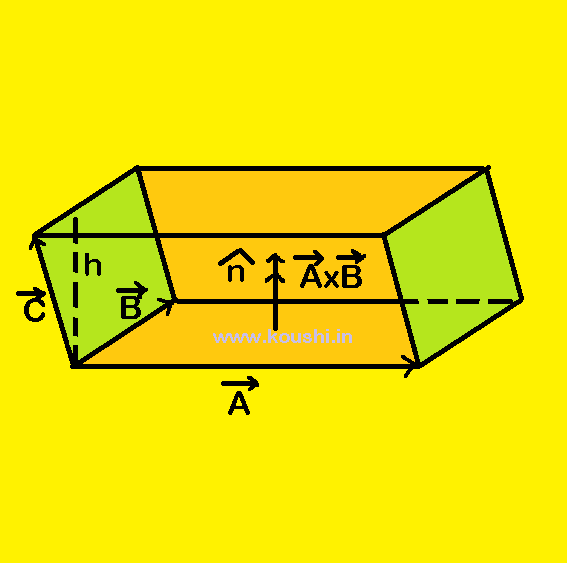
Vector triple product: ![]() .(
.(![]()
![]()
![]() ) =
) = ![]() .(
.(![]()
![]()
![]() ) =
) = ![]() .(
.(![]()
![]()
![]() )
)
If ![]() =
= ![]() ,
, ![]() =
= ![]() and
and ![]() =
= ![]() then,
then,
![]() .(
.(![]()
![]()
![]() ) =
) =  = –
= –  =
=  =
= ![]() .(
.(![]()
![]()
![]() )
)
![]() .(
.(![]()
![]()
![]() ) =
) =  = –
= –  =
=  =
= ![]() .(
.(![]()
![]()
![]() )
)
Therefore, ![]() .(
.(![]()
![]()
![]() ) =
) = ![]() .(
.(![]()
![]()
![]() ) =
) = ![]() .(
.(![]()
![]()
![]() ).
).
![]() .(
.(![]()
![]()
![]() ) =
) =  =
= ![]() +
+ ![]() +
+ ![]()
If ![]() ,
, ![]() and
and ![]() are coplanar then
are coplanar then ![]() .(
.(![]()
![]()
![]() ) = 0.
) = 0.
Example: What is the value of a, for which ![]() = (4î –ĵ +3k̂),
= (4î –ĵ +3k̂), ![]() = (2î +ĵ -2k̂) and
= (2î +ĵ -2k̂) and ![]() = (aî + ĵ – k̂) are the coplanar vectors?
= (aî + ĵ – k̂) are the coplanar vectors?
Here ![]() .(
.(![]()
![]()
![]() ) = 0
) = 0
Or,  = 0
= 0
Or, 4(-1+2) -1(-2a +2) +3(2-a) = 0
Or, 4+2a-2+6-3a = 0
![]() a = 8.
a = 8.
5. Equation of a plane and distance of plane from origin:
![]() = 2î+3ĵ+2k̂ is perpendicular to a plane. The terminal point of another vector
= 2î+3ĵ+2k̂ is perpendicular to a plane. The terminal point of another vector ![]() = î+2ĵ+k̂ touches the plane. Find the equation of the plane.
= î+2ĵ+k̂ touches the plane. Find the equation of the plane.
Let us consider Q is a point on the plane with coordinates (x, y, z). The position vector of point Q is xî + yĵ + zk̂.
![]() = (1 – x)î + (2 – y)ĵ+(1 – z)k̂ is lying on the plane which is perpendicular to
= (1 – x)î + (2 – y)ĵ+(1 – z)k̂ is lying on the plane which is perpendicular to ![]() .
.
Therefore, ![]() .
.![]() = 0
= 0
Or, (2î + 3ĵ + 2k̂).[(1 – x)î + (2 – y)ĵ + (1 – z)k̂] = 0
Or, 2(1 – x) + 3(2 – y) + 2(1 – z) = 0
Or, 2 – 2x + 6 – 3y + 2 – 2z = 0

![]() 2x + 3y + 2z = 10
2x + 3y + 2z = 10
The distance of plane from origin is projection of ![]() on
on ![]() =
= ![]() .
.![]() =
= ![]() =
= ![]() .
.
